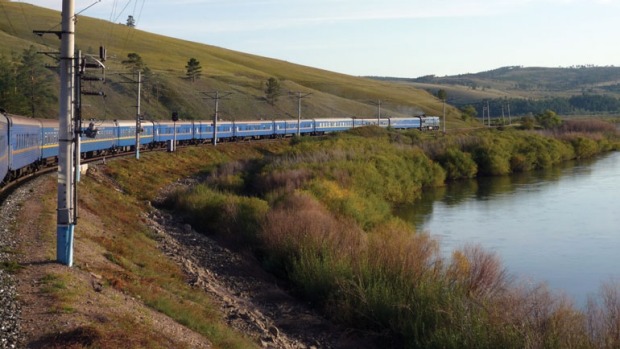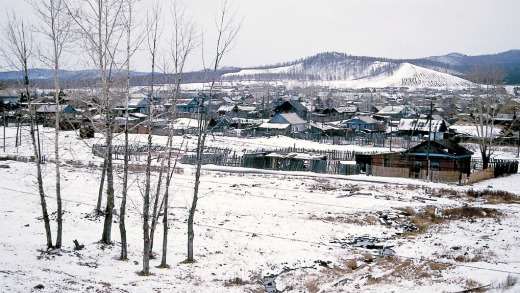
It's an adventure that tops the bucket lists of many - embarking on the world's longest railway line through some of the harshest and most beautiful terrain in the world. Siberia.
Beyond those snow-covered pines you'll find warm Russian hospitality, abundant supplies of vodka and a generous dollop of sour cream with every meal.
And finally, an excuse to wear one of those fur pillbox hats out of Doctor Zhivago.

If you're still not convinced, here are seven reasons to jump aboard the Trans-Siberian railway:
This isn't a trip for those wanting to laze on beaches by day and party by night.
But it's nirvana for adventure junkies, cultural types and history buffs.
There's natural beauty, wildlife and plenty to do outdoors - dog sledding and skiing in winter, rockclimbing, river rafting.
Russia is home to some of the world's best museums, art collections, ballet schools and theatres, not to mention a fascinating and at times painful history.
St Petersburg's Hermitage Museum and the Leningrad Blockade Museum are a must, along with the Mariinsky Theatre and Moscow's Bolshoi Theatre.
From soups, blinis and dumplings to stroganoff and chicken kiev, Russian food is hearty, full of flavour and usually topped with smetana (sour cream) and a sprinkle of dill.
You can't go past a tangy solyanka or borscht soup when it's freezing cold outside, washed down with a warm sbiten (a spiced honey drink, either alcoholic or non-alcoholic).
Or a warm, buttery blini (pancake) topped with salmon caviar and horseradish cream.
There's also delicious cuisine from former Soviet republics in Central Asia and the Caucasus, such as charcoal-grilled pork shashlyk and halva.
While sub-zero temperatures don't exactly scream fun, standing in the snow at Red Square, surrounded by the Kremlin, the colourful onion domes of St Basil's cathedral and the twinkling lights of the famous GUM shopping mall can only be described as magical.
The good news is that Russia does coffee and dessert really, really well. The blistering cold gives you plenty of excuses to thaw out with a cuppa and some of the best treats you've eaten in your life, like blinis stuffed with apple and drizzled with caramel sauce.
Indoors or on the train, you'll never be cold. In fact, being inside gets unbearably hot when you're all rugged up, so layering is important.
And, if you can handle temperatures of almost 100 degrees Celsius, you can sweat up a storm in a traditional Russian banya (sauna).
Travelling in platzkart (third class) on the train is the best way to meet locals, since most tourists opt for second class.
Carriages are open plan with no doors or curtains and each compartment sleeps four, with another two across the corridor. There are usually two toilets to a carriage, with a samovar of boiling water for tea, coffee and instant noodles (handy, since food on the train is pricey) and a provodnitsa (carriage attendant).
Bring some food to share - it won't be five minutes before the babushka across from you is plying you with sausages and fruit.
Few locals speak English and they're incredibly patient with tourists who don't speak the language.
The language barrier won't stop them trying to learn more about you, or going to great lengths to help you find your way.
From the cities to the countryside, the landscapes to the architecture, there's no shortage of breathtaking beauty in Russia.
Any trip to Siberia must include a stop at Lake Baikal, the oldest and deepest lake in the world. Many tourists experience the lake from the quaint little village of Listvyanka where you can devour smoked Baikal omul on the shore while taking in the view.
It's also worth visiting the lake's largest island, Olkhon, with its picturesque cliffs dotted with shamanic sacred sites and offerings.
In Krasnoyarsk, further west, the trees of Stolby national park display every shade of green imaginable while the historic town of Suzdal, near Moscow, with its countless examples of Russia's famous onion dome churches, looks like something out of a fairytale.
And after passing through all those little Siberian towns and cities, the grandeur of European Russia will leave you gobsmacked - Moscow with its incredible Red Square and dazzling metro stations and St Petersburg with its Venetian-inspired canals, bridges and opulent palaces.
The Trans-Siberian railway is by no means a secret yet to be discovered by the masses but travellers, particularly tour groups, tend to make the standard stops (Irkutsk, Yekaterinburg, Suzdal, Moscow, St Petersburg).
Veering off that well-worn path you'll find barely any tourism infrastructure and you probably won't bump into another tourist for weeks, but you'll hang out where the locals do and those places deliver some of the best experiences.
The city of Perm doesn't come highly recommended by the guide books, or fellow travellers, but the friendly people we met there left us with some of our best memories from the entire trip - from the women at our hotel who would worry over how cold our hands were whenever we came back from exploring and put on afternoon tea to warm us up, to the couple who drove us to our destination even though it was out of their way when we asked them what bus to catch.
The Russian rouble has been through some tough times of late which is great news for Australian travellers, with one Australian dollar currently buying more than 50 roubles.
Food, accommodation and transport are incredibly affordable regardless of the exchange rate and while prices do rise as you approach Moscow, they're still reasonable.
Budget travellers can find good, cheap food at Soviet-style self-serve canteens and although hostels are thin on the ground in smaller cities, more are popping up.
Taxis are significantly cheaper if booked by a hostel/hotel.
AAP